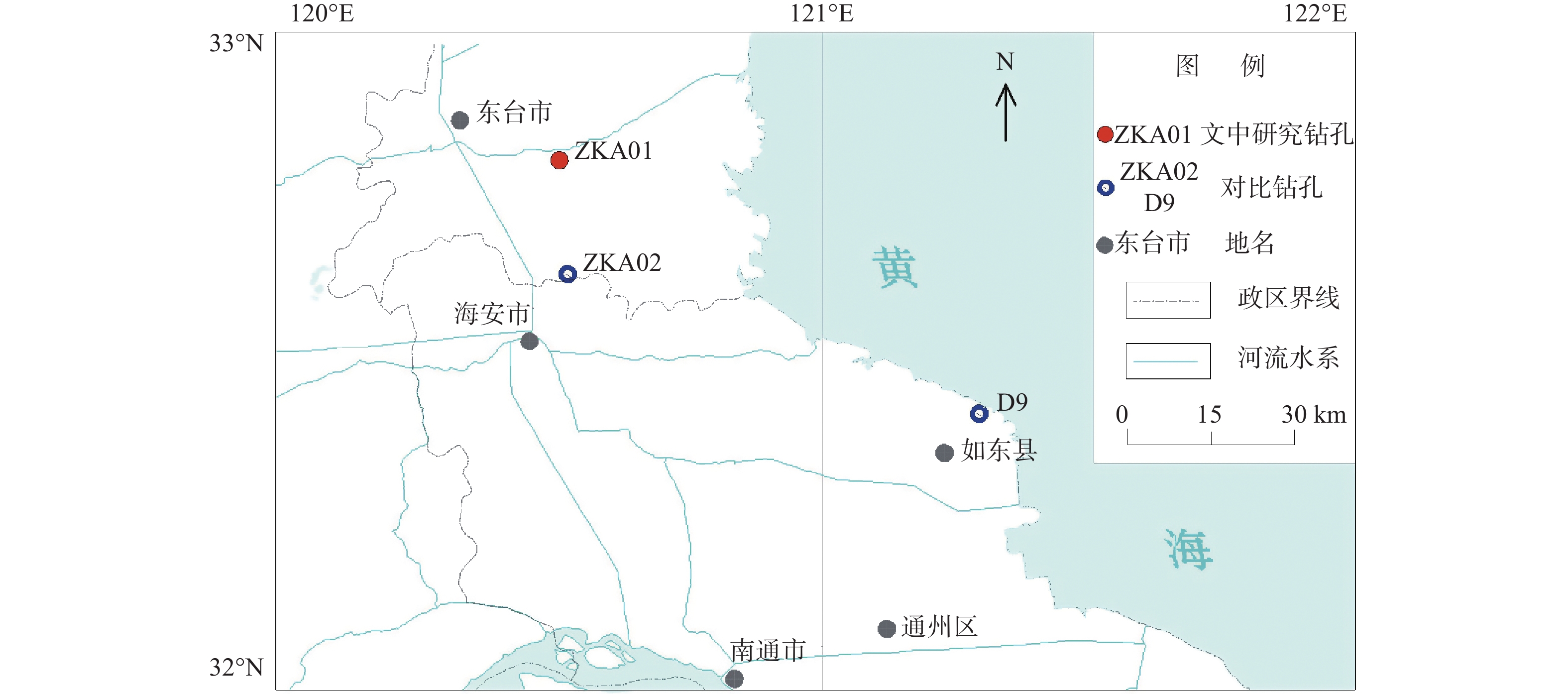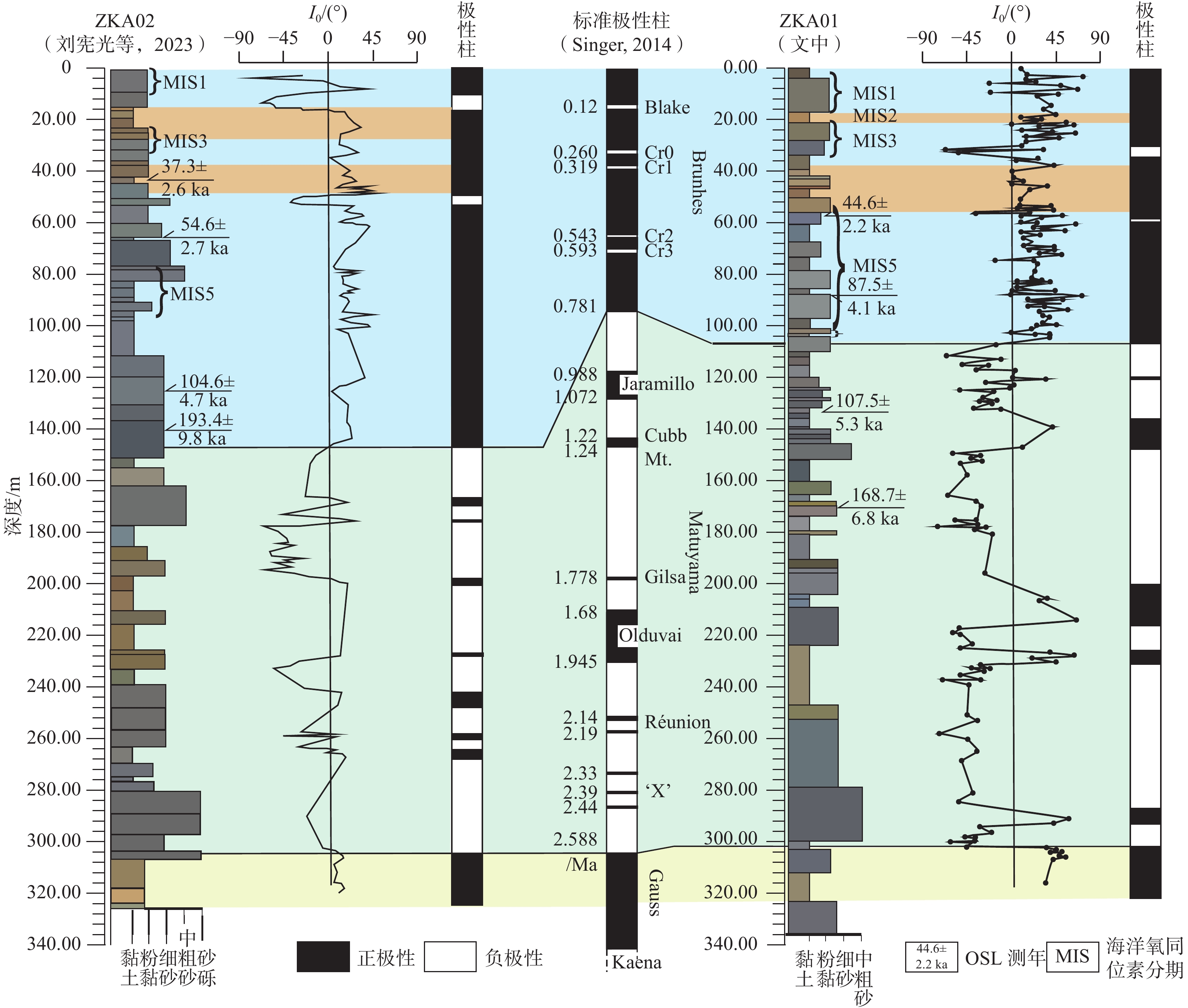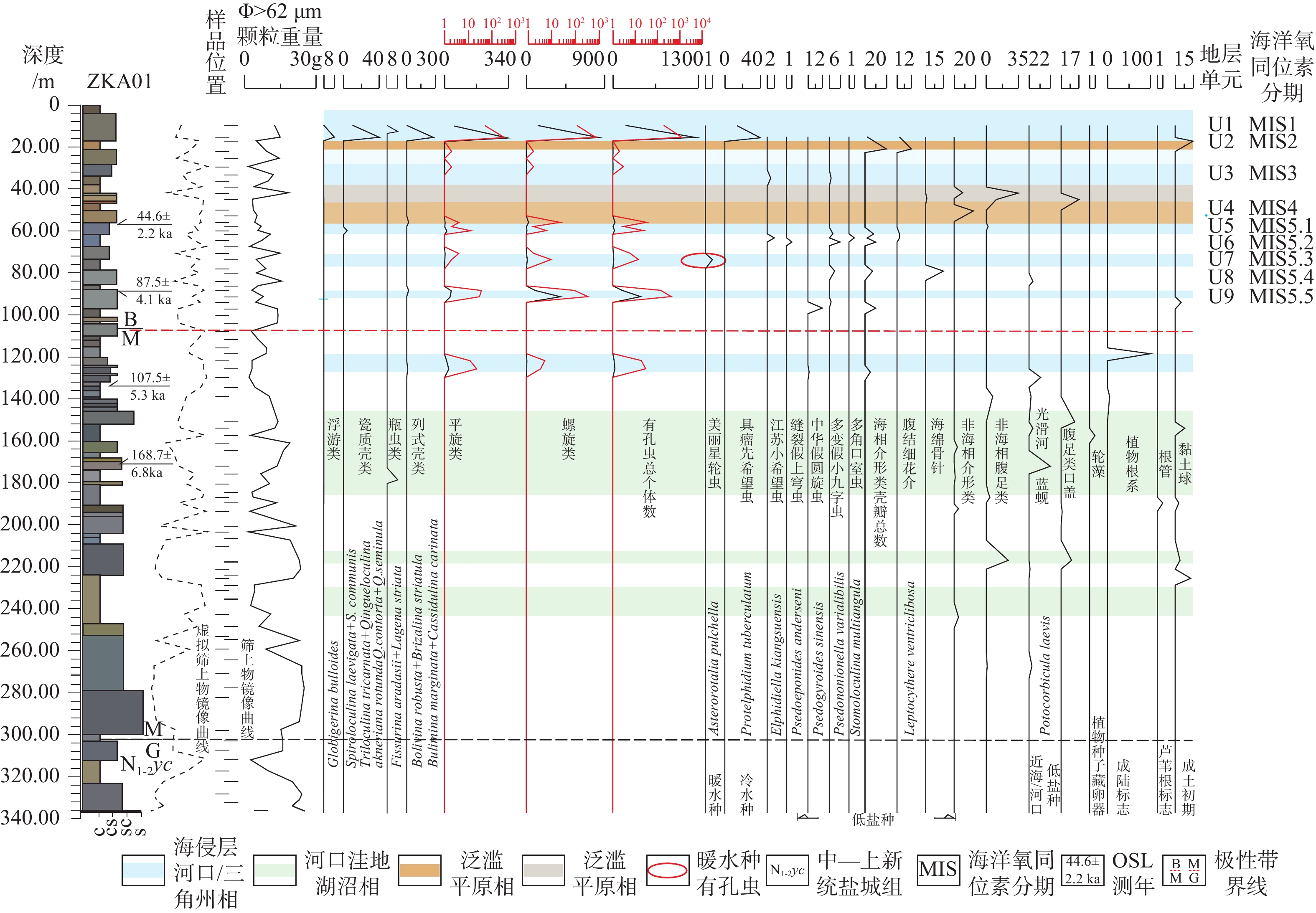Evolution of sedimentary environment at the ZKA01 borehole in the north wing of the Yangtze River Delta since late Quaternary
-
摘要: 第四纪晚期以来的年代地层框架及海侵问题一直以来都是长江三角洲地区的研究热点。由于长江三角洲地区河道往复摆动、河流下切侵蚀导致地层频繁缺失,目前尚未在该地区同一个钻孔内发现完整的海侵记录。基于长江三角洲北翼东台地区ZKA01钻孔岩石地层、生物地层、古地磁年代学和光释光(OSL)测年研究,对比区域钻孔资料确定了该孔第四纪以来的地层年代框架,发现ZKA01钻孔完整地记录了晚更新世以来长江三角洲地区的5次海侵事件。结果表明,ZKA01孔B/M界线位置在108.00 m处,M/G界线位置为300.25 m处。中、上更新统界线位于第Ⅲ海相层底部,即92.95m处。上更新统与全新统界线置于该钻孔发现的第Ⅰ海相层底部,即16.65m处。晚更新世以来,前3次海侵发生在MIS5(128~74 ka)阶段,其中MIS5.1海侵规模较大,仅次于全新世时期的海侵规模。第4次海侵发生在MIS3阶段(60~24 ka),在深度上和年代上相当于MIS3时期的“第Ⅱ海相层”。第5次海侵发生在MIS1(12 ka至今)阶段,沉积环境为滨岸浅水的浅海环境,该次海侵规模最大。同时发现MIS5阶段初次海侵记录在该地区各钻孔埋深大致相当,该界面可作为长江三角地区的地层划分与对比研究的标志性地层。以上研究成果对于长江三角洲地区第四纪晚期地层划分对比、沉积环境研究分析具有极其重要意义。Abstract: The late Quaternary chronostratigraphic framework and marine transgression have long been research focal points in the Yangtze River Delta. The frequent channel oscillation and river incision in the Yangtze Delta have led to the frequent absence of complete stratigraphic records. Complete marine transgression records have yet to be discovered within the same borehole in this region. Based on lithostratigraphy, biostratigraphy, paleomagnetic chronology, and OSL dating studies of the ZKA01 borehole in the Dongtai area of the northern wing of the Yangtze River Delta region, the stratigraphic chronology framework since Marine Isotope Stage 5 (MIS5) was established. The ZKA01 borehole was found to have comprehensively recorded five marine transgression events in the Yangtze Delta region since late Pleistocene. The results indicate that the B/M boundary of the ZKA01 borehole is located at 108 m, and the M/G boundary is at 300.25 m. The boundary between the Middle and Upper Pleistocene is positioned at the bottom of the third marine transgression layer, precisely at 92.95 m. The boundary between the Upper Pleistocene and Holocene boundaries is located at the bottom of the first marine transgression layer discovered in the borehole, precisely at 16.65 m. The first three transgressions occurred during MIS5 (128–74 ka), of which MIS 5.1 had a larger scale, second only to the scale of the transgressions during the Holocene. The fourth transgression occurred during MIS3 (60–24 ka), equivalent in depth and age to the "II marine phase layer" of MIS3. The fifth transgression occurred during MIS1 (12 ka to present), depositing in a nearshore shallow marine environment, with the largest scale observed. Additionally, it was identified that the first transgression layer (MIS5) is approximately equivalent in burial depth across various regional boreholes, serving as a distinctive stratigraphic marker for stratigraphic division and comparative studies in the Yangtze River Delta. These research findings hold significant importance for Quaternary stratigraphic division and comparative analysis of sedimentary environments in the Yangtze River Delta.
-
Key words:
- Yangtze River Delta /
- Chronology /
- Stratum /
- Sedimentary environment /
- Microfossils /
- MIS5 /
- Marine transgression
-
表 1 ZKA01钻孔光释光测年数据
Table 1. OSL dating data of the ZKA01 borehole
样品编号 岩性特征 深度/m 等效剂量
/Gy年剂量
Gy/ka含水量/% 年龄/ka 14G−172 粉砂 58.90 140.27±3.83 3.14±0.13 22.3 44.6±2.2 14G−173 粉细砂 88.10 284.63±7.01 3.25±0.13 24.7 87.5±4.1 14G−174 粉砂 133.10 410.73±11.70 3.82±0.15 22.9 107.5±5.3 14G−175 粉细砂 169.90 578.59±1.34 3.43±0.14 16.5 168.7±6.8 -
[1] All China Commission of Stratigraphy, 2002, China Regional Chronostratigraphy (Geological Chronology) Table Instructions [M], Beijing: Geosciences Press: l-72(in Chinese with English abstract) [2] CHEN B Z, LI C X, YE Z Z, 1991. Holocene bottom boundary and “Hard Clay Band” in the northern flank of the Changjiang River Delta[J]. Marine Geology & Quaternary Geology, 11(2): 37-46. (in Chinese with English abstract) [3] CHEN Z D, QIN Z S, LIANG H, et al. , 2002. High-resolution stratigraphic correlation method of the Quaternary in the Hangzhou-Jiaxing-Huzhou plain[J]. Geology in China, 29(3): 275-280. (in Chinese with English abstract) [4] FAN D D, LI C X, CHEN M F, et al. , 2001. Quantitative analyses on diastems of the mudflat deposits in the Yangtze river delta[J]. Marine Geology & Quaternary Geology, 21(4): 1-6. (in Chinese with English abstract) [5] HU Y Z, XU Q M, YUAN G B, et al. , 2014. Magnetostratigraphy of borehole CK3 and record of the Quaternary volcanic activities in Xiaoshan of Haixing, Hebei Province[J]. Journal of Palaeogeography, 16(3): 411-426. (in Chinese with English abstract) [6] JIANG R, YANG Z L, YU J J, et al. , 2014. Stratigraphic division of Quaternary strata and paleoenviroment analysis for Xinghua-Tongzhou region in the north flank of the Yangze River delta[J]. Resources Survey Environment, 35(4): 263-269. (in Chinese with English abstract) [7] LAO J X, YANG Z L, YU J J, et al. , 2016. Quaternary multistratigraphic study of Borehole ZK10, Xinghua, Jiangsu Province[J]. Geological Bulletin of China, 35(10): 1705-1714. (in Chinese with English abstract) [8] LI C X, WANG P X, 1998. Study on late quaternary estuary stratigraphy of the Yangtze River[M]. Beijing: Science Press: 1-222. (in Chinese) [9] LI C X, CHEN Q Q, FAN D D, et al. , 1999. Palaeogeography and palaeoenvironment in Changjiang delta since last glaciation[J]. Journal of Palaeogeography, 1(4): 12-25. (in Chinese with English abstract) [10] LI C X, WANG Q, FAN D D, 2013. Chapter 15, Marine delta sediment[M]//FENG Z Z. China Sedimentology. 2nd ed. Beijing: Petroleum Industry Press: 812-905. (in Chinese) [11] LIN C M, ZHANG X, DENG C W, et al. , 2016. Sedimentary characteristics and environmental evolution of the Late Quaternary incised-valley fills in the Nantong Area of Jiangsu Province, China[J]. Acta Sedimentologica Sinica, 34(2): 268-280. (in Chinese with English abstract) [12] LIN Z Y, JIN X L, GUAN M L, et al. , 2019. Quaternary sedimentary sequence of the southern Yangtze River Delta and its coupling with paleoenvironmental evolution[J]. Science Technology and Engineering, 19(13): 15-24. (in Chinese with English abstract) [13] LIU X G, YANG J W, HU L, et al. , 2023. Research on Quaternary multiple stratigraphic division of ZKA02 in the North Flank of the Yangtze river delta[J]. Journal of Stratigraphy, 47(1): 49-58. (in Chinese with English abstract) [14] LIU Z R, XUE H Y, WANG C S, 2021. Late Quaternary depositional characteristics and environment significance of the Xibozhang section in Baoding, central Hebei Plain, China[J]. Journal of Geomechanics, 27(6): 1011-1023. (in Chinese with English abstract) [15] MIAO W D, LI S J, WANG R H, 2009. Preliminary Study On Sedimentary Characteristics and stratum division of J9 core in the North Wing of the Yangtze River delta[J]. Quaternary Sciences, 29(1): 126-134. (in Chinese with English abstract) [16] MIAO W D, LI S J, FENG J S, et al. , 2016. Stratigraphic division of NB5 core in the Yangtze delta area and its environmental change information[J]. Geology in China, 43(6): 2022-2035. (in Chinese with English abstract) [17] SINGER B S, 2014. A Quaternary geomagnetic instability time scale[J]. Quaternary Geochronology, 21: 29-52. doi: 10.1016/j.quageo.2013.10.003 [18] SUN F R, YANG J W, LIU X G, et al. , 2019. The ups and downs of the ancient ground in the front of the northern wing of the Yangtze River Delta during the Last Glacial Maximum[J]. Mineral Exploration, 10(5): 1038-1043. (in Chinese with English abstract) [19] WANG H, ZHENG X M, QIAN P, et al. , 2021. An overview on the first hard soil layer (FHSL) of the Late Pleistocene in the Yangtze River Delta[J]. Quaternary Sciences, 41(6): 1771-1780. (in Chinese with English abstract) [20] WANG P X, MIN Q B, BIAN Y H, et al. , 1981. Strata of Quaternary transgressions in east China: a preliminary study[J]. Acta Geologica Sinica, 55(1): 1-13. (in Chinese with English abstract) [21] WANG P X, BIAN Y H, 1986. Ostracod/foraminifer ratios as indicators of sedimentary environments[J]. Acta Micropalaeontologica Sinica, 3(1): 37-50. (in Chinese with English abstract) [22] WANG Q, TIAN G Q, 1999. The Neotectonic setting of Late Quaternary transgressions on the Eastern Coastal plain of China[J]. Journal of Geomechanics, 5(4): 41-48. (in Chinese with English abstract) [23] WANG Q, YUAN G B, HU Y Z, et al. , 2008. Microfossils in tidal flat strata on the northern Huanghua area since the MIS 3[J]. Acta Micropalaeontologica Sinica, 25(1): 1-18. [24] WANG Q, ZHANG Y F, YUAN G B, et al. , 2008. Since MIS 3 stage the correlation between transgression and climatic changes in the north Huanghua area, Hebei[J]. Quaternary Sciences, 28(1): 79-95. (in Chinese with English abstract) [25] WANG Q, LI C X, 2009. The type of Quaternary sequence in the East China coastal plain[J]. Marine Geology & Quaternary Geology, 29(4): 39-51. (in Chinese with English abstract) [26] WANG Y, ZHANG Z K, ZHU D K, et al. , 2006. River-sea interaction and the North Jiangsu Plain formation[J]. Quaternary Sciences, 26(3): 301-320. (in Chinese with English abstract) [27] WANG Z B, YANG S Y, WANG Q, et al. , 2014. Late Quaternary stratigraphic evolution on the outer shelf of the East China Sea[J]. Continental Shelf Research, 90: 5-16. doi: 10.1016/j.csr.2014.04.015 [28] WANG Z B, ZHANG J Y, MEI X, et al. , 2020. The stratigraphy and depositional environments of China′s sea shelves since MIS5 (74-128) ka[J]. Geology in China, 47(5): 1370-1394. (in Chinese with English abstract) [29] WANG Z H, QIU J B, RAN L H, et al. , 2004. Chronostratigraphy and transgression/regression during Late Pleistocene in the southern Changjiang (Yangtze) River Delta Plain[J]. Marine Geology & Quaternary Geology, 24(4): 1-8. (in Chinese with English abstract) [30] WU B Y, LI C X, 1987. Quaternary geology in Changjiang delta[M]. Beijing: Geological Publishing House, 1-166. (in Chinese) [31] WEI Y, HAN F, WEI N Y, et a1.2011, Discovery and Geological Significance of Late Pleistocene-Holocene Marine Facies Foraminifer Assemblage in Daqiao Town, Jiangdu, Jiangsu Province[J]. Geological Science and Technology Information , 2011, 30(3): 66-72. (in Chinese with English abstract) [32] XIA F, YIN Y, WANG Q, et al. , 2012. Sequence stratigraphy of the central part of North Jiangsu coasts since Late MIS 3, Eastern China[J]. Acta Geologica Sinica, 86(10): 1696-1712. (in Chinese with English abstract) [33] YANG D Y, CHEN K F, SHU X M, 2004. A preliminary study on the paleoenvironment during MIS 3 in the Changjiang delta region[J]. Quaternary Sciences, 24(5): 525-530. (in Chinese with English abstract) [34] YAO Z Q, GUO Z T, CHEN Y K, et al. , 2006. Magnetostratigraphy of marine-terrigenous facies deposits in Bohai Bay[J]. Marine Geology & Quaternary Geology, 26(1): 9-15. (in Chinese with English abstract) [35] YU J J, HU F, YANG Z L, et al. , 2014. Identification of Holocene foraminifera assemblages in Sijia Town of Nantong City, Jiangsu Province, and its geological significance[J]. Geological Bulletin of China, 33(10): 1609-1620. (in Chinese with English abstract) [36] YU J J, LAO J X, JIANG R, et al. , 2016. Reconstruction of the Late Quaternary palaeoenvironment on the north wing of Yangtze River Delta, based on comparative study of the multistratigraphies[J]. Geological Bulletin of China, 35(10): 1692-1704. (in Chinese with English abstract) [37] ZHANG H, SHI G, WU H, et al. , 2021. Quaternary activity of the Luodian-Zhoupu buried fault in the Shanghai region: integrated exploration and research[J]. Journal of Geomechanics, 27(2): 267-279. (in Chinese with English abstract) [38] ZHANG M H, WANG J . 2003, Environmental significance of Holocene foraminiferal assemblages in Shanggang, Yancheng[J]. Marine Geology Letters19(9): 5-8. (in Chinese with English abstract) [39] ZHANG Z K, XIE L, ZHANG Y F, et al. , 2010. Sedimentary records of the MIS 3 transgression event in the North Jiangsu Plain, China[J]. Quaternary Sciences, 30(5): 883-891. (in Chinese with English abstract) [40] 陈报章, 李从先, 业治铮, 1991. 长江三角洲北翼全新统底界和“硬粘土层”的讨论[J]. 海洋地质与第四纪地质, 11(2): 37-46. [41] 陈忠大, 覃兆松, 梁河, 等, 2002. 杭嘉湖平原第四纪地层高精度对比方法研究[J]. 中国地质, 29(3): 275-280. doi: 10.3969/j.issn.1000-3657.2002.03.007 [42] 范代读, 李从先, 陈美发, 等, 2001. 长江三角洲泥质潮坪沉积间断的定量分析[J]. 海洋地质与第四纪地质, 21(4): 1-6. [43] 胡云壮, 胥勤勉, 袁桂邦, 等, 2014. 河北海兴小山CK3孔磁性地层与第四纪火山活动记录[J]. 古地理学报, 16(3): 411-426. [44] 蒋仁, 杨祝良, 于俊杰, 等, 2014. 长江三角洲北翼兴化-通州地区第四纪地层划分及古环境分析[J]. 资源调查与环境, 35(4): 263-269. [45] 劳金秀, 杨祝良, 于俊杰, 等, 2016. 江苏兴化ZK10孔第四纪多重地层研究[J]. 地质通报, 35(10): 1705-1714. doi: 10.3969/j.issn.1671-2552.2016.10.018 [46] 李从先, 汪品先, 1998. 长江晚第四纪河口地层学研究[M]. 北京: 科学出版社: 1-222. [47] 李从先, 陈庆强, 范代读, 等, 1999. 末次盛冰期以来长江三角洲地区的沉积相和古地理[J]. 古地理学报, 1(4): 12-25. doi: 10.3969/j.issn.1671-1505.1999.04.002 [48] 李从先, 王强, 范代读, 2013. 第十五章 海洋三角洲沉积[M]//冯增昭. 中国沉积学. 2版. 北京: 石油工业出版社: 812-905. [49] 林春明, 张霞, 邓程文, 等, 2016. 江苏南通地区晚第四纪下切河谷沉积与环境演变[J]. 沉积学报, 34(2): 268-280. [50] 林钟扬, 金翔龙, 管敏琳, 等, 2019. 长江三角洲南翼第四纪沉积层序及其与古环境演变的耦合[J]. 科学技术与工程, 19(13): 15-24. [51] 刘宪光, 杨晋炜, 胡利, 等, 2023. 长江三角洲北翼ZKA02孔第四纪多重地层划分研究[J]. 地层学杂志, 47(1): 49-58. [52] 刘智荣, 薛怀宇, 王昌盛, 2021. 河北平原中部保定西伯章剖面晚第四纪沉积特征及其环境意义[J]. 地质力学学报, 27(6): 1011-1023. [53] 缪卫东, 李世杰, 王润华, 2009. 长江三角洲北翼J9孔岩芯沉积特征及地层初步划分[J]. 第四纪研究, 29(1): 126-134. [54] 缪卫东, 李世杰, 冯金顺, 等, 2016. 长江三角洲NB5孔第四纪地层划分及环境变化信息[J]. 中国地质, 43(6): 2022-2035. [55] 全国地层委员会, 2002, 中国区域年代地层(地质年代)表说明书[M], 北京: 地质出版社: l-72. [56] 孙丰瑞, 杨晋炜, 刘宪光, 等, 2019. 末次盛冰期长江三角洲北翼前缘古地面的起伏[J]. 矿产勘查, 10(5): 1038-1043. [57] 王辉, 郑祥民, 钱鹏, 等, 2021. 长江三角洲晚更新世第一硬土层研究进展[J]. 第四纪研究, 41(6): 1771-1780. [58] 汪品先, 闵秋宝, 卞云华, 等, 1981. 我国东部第四纪海侵地层的初步研究[J]. 地质学报, 55(1): 1-13. [59] 汪品先, 卞云华, 1986. 介形虫/有孔虫比值作为沉积环境的标志[J]. 微体古生物学报, 3(1): 37-50. [60] 王强, 田国强, 1999. 中国东部晚第四纪海侵的新构造背景[J]. 地质力学学报, 5(4): 41-48. doi: 10.3969/j.issn.1006-6616.1999.04.005 [61] 王强, 张玉发, 袁桂邦, 等, 2008. MIS 3阶段以来河北黄骅北部地区海侵与气候期对比[J]. 第四纪研究, 28(1): 79-95. doi: 10.3321/j.issn:1001-7410.2008.01.009 [62] 王强, 李从先, 2009. 中国东部沿海平原第四系层序类型[J]. 海洋地质与第四纪地质, 29(4): 39-51. [63] 王颖, 张振克, 朱大奎, 等, 2006. 河海交互作用与苏北平原成因[J]. 第四纪研究, 26(3): 301-320. doi: 10.3321/j.issn:1001-7410.2006.03.001 [64] 王张华, 丘金波, 冉莉华, 等, 2004. 长江三角洲南部地区晚更新世年代地层和海水进退[J]. 海洋地质与第四纪地质, 24(4): 1-8. doi: 10.16562/j.cnki.0256-1492.2004.04.001 [65] 王中波, 张江勇, 梅西, 等, 2020. 中国陆架海MIS5(74~128 ka)以来地层及其沉积环境[J]. 中国地质, 47(5): 1370-1394. doi: 10.12029/gc20200506 [66] 吴标云, 李从先, 1987. 长江三角洲第四纪地质[M]. 北京: 海洋地质出版社: l-166. [67] 韦一, 韩芳, 魏乃颐, 等, 2011, 江苏江都市大桥镇晚更新世晚期—全新世有孔虫动物群的发现及其地质意义[J]. 地质科技情报, 2011, 30(3): 66-72. [68] 夏非, 殷勇, 王强, 等, 2012. MIS 3晚期以来江苏中部海岸的层序地层[J]. 地质学报, 86(10): 1696-1712. doi: 10.3969/j.issn.0001-5717.2012.10.009 [69] 杨达源, 陈可锋, 舒肖明, 2004. 深海氧同位素第3阶段晚期长江三角洲古环境初步研究[J]. 第四纪研究, 24(5): 525-530. doi: 10.3321/j.issn:1001-7410.2004.05.008 [70] 姚政权, 郭正堂, 陈宇坤, 等, 2006. 渤海湾海陆交互相沉积的磁性地层学[J]. 海洋地质与第四纪地质, 26(1): 9-15. doi: 10.16562/j.cnki.0256-1492.2006.01.002 [71] 于俊杰, 胡飞, 杨祝良, 等, 2014. 江苏南通市四甲镇全新世以来有孔虫动物群的发现及其地质意义[J]. 地质通报, 33(10): 1609-1620. doi: 10.3969/j.issn.1671-2552.2014.10.019 [72] 于俊杰, 劳金秀, 蒋仁, 等, 2016. 基于多重地层对比研究还原长江三角洲北翼晚第四纪古环境演变[J]. 地质通报, 35(10): 1692-1704. doi: 10.3969/j.issn.1671-2552.2016.10.017 [73] 张浩, 施刚, 巫虹, 等, 2021. 上海罗店-周浦隐伏断裂第四纪活动性综合探测与研究[J]. 地质力学学报, 27(2): 267-279. doi: 10.12090/j.issn.1006-6616.2021.27.02.025 [74] 张茂恒, 王建. 2003, 盐城上岗全新世有孔虫组合的环境意义[J]. 海洋地质动态, 19(9): 5-8. [75] 张振克, 谢丽, 张云峰, 等, 2010. 苏北平原MIS 3阶段海侵事件的沉积记录[J]. 第四纪研究, 30(5): 883-891. doi: 10.3969/j.issn.1001-7410.2010.05.05 -






 下载:
下载:






